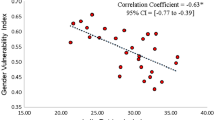Abstract
This article analyzes forms, structure, drivers and implications of inequalities in Ghana; examines its political economy and suggests remedial policy options and challenges. Regarding economic inequalities, it shows that despite a general reduction in the incidence of income poverty, its depth has increased: with a wider income distribution gap between the poorest and richest households; marked disparities between the well-endowed South and the impoverished North; and a gendered bias in the distribution of wealth assets. Overall, the non-diversified nature of Ghana’s recent rapid growth has not boosted employment or reduced inequalities.








Similar content being viewed by others
Notes
In 2010, the service sector contributed more than half (51 percent) to the GDP, while the agricultural sector maintained its receding importance at 32 percent. The report further indicates that with the recent rebasing of GDP by the Ghana Statistical Service, the overall contribution of agriculture has declined to about 30 percent and in 2011, the relative contribution to GDP reached the lowest and the sector became the smallest of the three sectors.
References
Andre, Pierre and Sandrine Mesplé-Somps (2010) ‘Politics and the Geographic Allocation of Public Funds in a Semi-Democracy. The case of Ghana, 1996–2004’, G-MonD Working Paper (2010).
Aryeetey, Ernest, George Owusu and Emmanuel Joseph Mensah (2009) ‘An Analysis of Poverty and Regionalinequalities in Ghana’, Global Development Network (GDN) Working Paper Series, No. 27, October.
Asante, Richard and Emmanuel Gyimah-Boadi (2004) Ethnic Structure, Inequality, and Governance of the Public Sector in Ghana. Geneva: UNRISD.
Cooke, Edgar F.A., Sarah Hague, John Cockburn, Abdel-Rahmen El Lahga and Luca Tiberti (2014) ‘Estimating the Impact on Poverty of Ghana’s Fuel Subsidy Reform and a Mitigating Response’, UNICEF working paper 2014–02.
Coulombe, Harold and Quentin Wodon (2007) ‘Poverty, livelihoods, and access to basic services in Ghana’, The World Bank Paper.
Dickson, Kwamina B. (1975) ‘Development Planning and National Integration in Ghana’, in David R. Smock and Kwamena Bentsi-Enchill (eds.) The Search for National Integration in Africa. pp 100–116. New York: The Free Press.
FAO (2012) ‘Gender inequalities in rural employment in Ghana: An overview’ Prepared by the Gender, Equity and Rural Employment Division of FAO.
Ghana Statistical Service (1991) Ghana Living Standard Surveys (GLSS) Reports. Accra Ghana.
Ghana Statistical Service (1992) Ghana Living Standard Surveys (GLSS) Reports. Accra Ghana.
Ghana Statistical Service (1998) Ghana Living Standard Surveys (GLSS) Reports. Accra Ghana.
Ghana Statistical Service (1999) Ghana Living Standard Surveys (GLSS) Reports. Accra Ghana.
Ghana Statistical Service (2006) Ghana Living Standard Surveys (GLSS) Reports. Accra Ghana.
Ghana Statistical Service and the UNICEF (2006) Multiple Indicator Cluster Survey (MICS) Reports. Ghana: Ghana Statistical Service and UNICEF.
Ghana Statistical Service and the UNICEF (2011) Multiple Indicator Cluster Survey (MICS) Reports. Ghana: Ghana Statistical Service and UNICEF.
Oduro, Abena D., William Baah-Boateng and Louis Boakye-Yiadom (2011) Measuring the Gender Asset Gap in Ghana. Accra: University of Ghana and Woeli Publishing Services.
Participatory Development Associates (2011) Participatory Poverty and Vulnerability Assessment: Understanding the regional dynamics of poverty with particular focus on northern Ghana. Accra: Participatory Development Associates.
McLaughlin, James L. and David Owusu-Ansah (1994) ‘Historical Setting’, in La Verle Berry (eds.) A Country Study: Ghana. Washington DC: Library of Congress Federal Research Division Press.
Tsikata, Dzodzi and Wayo Seini (2004) ‘Identities, Inequalities and Conflicts in Ghana’, ISSER Working Paper 5.
World Bank (2009) Awakening Africa’s Sleeping Giant: Prospects for commercial agriculture in the Guinea Savannah zone and beyond. Washington DC: World Bank.
World Bank (2011) Tackling Poverty in Northern Ghana. Washington DC: World Bank.
World Bank (2014) ‘Overview of Ghana’s Economy’, The World Bank Country Context Report, Available at: http://www.worldbank.org/en/country/ghana/overview, accessed March 2014.
Additional information
An earlier version of this case-study was prepared for the Africa-wide Conference on ‘Inequalities in the context of Structural Transformation’, which was held in Accra, Ghana, on 28–30 April 2014. The article was commissioned by the Organizing Committee of the Conference. For more information, please visit http://africainequalities.org/conference/.
Explores inequalities in the context of structural transformation in Ghana (country case study prepared for the Accra Conference on African Inequalities)
According to the 2010 PHC, it is estimated that there are about 92 separate ethnic groups in Ghana. These groups are often classified into a few large groups, namely, Akan, Mole Dagbani, Ewe, Ga Adangbe, Guan and Gume (Gurma).
Rights and permissions
About this article
Cite this article
Osei-Assibey, E. Nature and Dynamics of Inequalities in Ghana. Development 57, 521–530 (2014). https://doi.org/10.1057/dev.2015.25
Published:
Issue Date:
DOI: https://doi.org/10.1057/dev.2015.25




